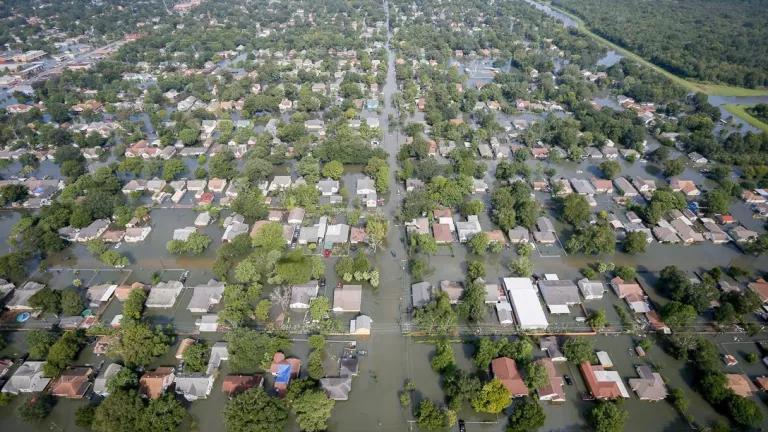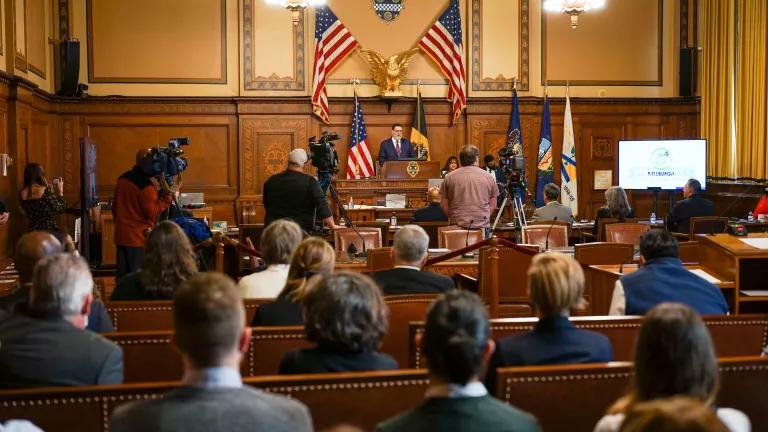After Harvey, Congress Still Stuck on Flood Insurance

One year ago, Hurricane Harvey made landfall in Texas. Harvey moved slowly north, dumping historic volumes of rain on the region, leaving Corpus Christie, Port Arthur, Houston, and hundreds of other communities struggling with widespread flooding, lost homes, and untold misery.
At that time, no one knew that Harvey would be the first of three major hurricanes that would strike the United States in 2017. Hurricanes Irma and Maria would devastate the Southeastern United States as well as Puerto Rico and the U.S. Virgin Islands.
These storms should have primed Congress to take swift and decisive action to reform the troubled National Flood Insurance Program (NFIP). Instead, Congress missed the September 30, 2017 deadline to reauthorize the program and passed a stopgap measure granting themselves two more months to finish their homework. They missed that deadline too, as well as five others. Congress has now kicked the can down the road a total of seven times over the past 11 months. We are still waiting for Congress to take action on reforming the NFIP.
Reforming flood insurance is just one piece of what needs to be a much larger strategy to help communities become more resilient and better able to withstand storms like Harvey. But it’s a critical piece. People rely upon the NFIP for information about flood risks, provide post-flood financial assistance, and help communities become safer from flooding. But the NFIP isn't designed to cope with the new reality of storms like Harvey, Irma, and Maria.
Over the past 11 months, Congress approved hurricane disaster assistance totaling $120 billion and forgave $16 billion of the NFIP’s outstanding debt. Forgiving billions in debt kept the program financially solvent, and able to pay damage claims resulting from Hurricanes Harvey, Irma, Maria, Nate, and 13 other flood disasters declared since the NFIP was originally set to lapse on September 30, 2017. But it was band-aid applied to a program with crippling problems that cost taxpayers billions of dollars and leaves homeowners trapped in a cycle of flood-rebuild-repeat.
To their credit, the U.S. House of Representatives passed flood insurance legislation that included several needed reforms, but they haven’t had an engaged partner in the U.S. Senate, where no serious conversations seem to be taking place.
Hurricane Harvey shined a bright light on many of the problems of flood insurance that Congress needs to address. Below are some of the problems that plague the NFIP and the actions NRDC recommends that Congress take to begin to fix them.
Fix the Problem of Repeatedly Flooded Homes
Prior to Hurricane Harvey, 4,889 of the 30,369 most flood-prone homes in the United States were in Texas. The Federal Emergency Management Agency (FEMA) classifies them as “Severe Repetitive Loss Properties.” These homes have flooded an average of five times and the NFIP has paid to rebuild them after each and every flood. Owners of these homes are, in a sense, trapped by the NFIP. As one homeowner said in a Houston Chronicle story: “You’re stuck. That’s the only way to put it.” While flood insurance provides assistance to rebuild in the same vulnerable location, assistance is hard to come by for people who would prefer to move to higher ground.
What Congress must do: Communities with a large number of repeatedly flooded homes should be required to address the problem. The House flood insurance reform bill that passed in November 2017 would require communities to identify areas that are prone to flooding and create long-term plans for reducing the potential for flood damages in those areas, preferably through the acquisition and demolition of the homes of willing sellers (and subsequent conversion to open space), elevating the structures so they are less likely to flood in the future, or some other flood risk reduction strategy. It’s important that local governments start to take action and that there is some accountability for fixing the flooding problems that are only going to get worse.
Help People Move to Higher Ground
Since 1985, Harris County, which includes Houston, has helped 2,075 families move out of areas that have flooded frequently. In Harvey’s aftermath the County is planning to spend $242 million for buyouts as part of a $2.5 billion public bonding initiative and will use a huge amount of federal disaster funding to buy out even more homes. But there are 107,000 homes located in floodplains in Harris County and millions more across the nation. Homeowners who are tired of the cycle of flooding and rebuilding should have the option to relocate in a timely manner. Nationwide, more than 30,000 properties have been flooded an average of five times each, and the NFIP has spent $5.5 billion to rebuild them after each flood. NRDC estimates that sea level rise may put 2.5 million more homes in the same situation, costing the NFIP $447 billion in the coming decades, absent reforms to the NFIP that make buyouts a more viable option.
What Congress must do: Through the NFIP, Congress should direct FEMA to provide more assistance to homeowners who would like to relocate, instead of rebuilding in the same vulnerable location after every flood. And Congress needs to make sure this assistance is delivered far more quickly. It currently takes 3–5 years for a family to receive relocation assistance from FEMA. Bipartisan legislation has passed the House and been introduced in the Senate that would require an assessment of why buyouts take so long and recommend ways to streamline the process. With flooding more prevalent and with sea levels rising, we must provide assistance to people who want to move out of harm’s way.
Increase Transparency and Require Disclosure of Flood Risks
It’s extremely difficult to find out a property’s history of flooding or what the risk of flooding might be. This is true for home buyers as well as current owners. Congress needs to fix this. After all, if people are denied access to good information, we cannot expect them to make good decisions.
In 21 states, home sellers are not explicitly required to tell prospective buyers whether a home has ever been damaged by flooding or if the home buyer will be legally required to purchase flood insurance. Texas is better than most states, requiring sellers to inform a buyer if a property has flooded in the past, but Texas doesn’t require that buyers be told if they have to buy flood insurance. This may partially explain why about 80 percent of those affected by Harvey didn't have flood insurance. NRDC released a report card on all 50 states flood disclosure laws and it’s shocking how little information home buyers receive in most states.
Even current owners find it difficult to learn their home’s flood history. If a homeowner is wondering whether they should buy flood insurance, they might call FEMA to find out if previous owners filed a flood a damage claim through the NFIP. But FEMA will not share this information, denying the current owner valuable information that would help them decide to purchase insurance or take steps to reduce their risk of flooding.
Finally, FEMA makes very little information about the flood insurance program publicly available. Community planners, researchers, and the public do not have an ability to find out how many repeatedly flooded homes may be in their neighborhood or even whether the city or town they live in is properly enforcing building and zoning codes that are supposed to steer development away from floodplains.
What Congress should do: Through the NFIP, Congress can fix all of these problems. The House of Representatives passed legislation in November 2017 that addressed all of these problems and the Senate simply needs to adopt them as well.
When Will Congress Take Action?
The next deadline for NFIP reform is November 30, but it’s not clear if Congress will be able to pass a comprehensive set of reforms, given that the Senate has yet to show signs of life.
Just last month, with yet another deadline for reform looming, Representatives Royce (R-CA) and Blumenauer (D-OR), with the backing of the House Financial Services Committee Chair, Representative Jeb Hensarling (R-TX), introduced bipartisan legislation with some commonsense reforms. The legislation would have also maintained a November 30, 2018 deadline to allow for debate on more complicated issues. Unfortunately, Representative Steve Scalise (R-LA) shut down action on this legislation. This kept the program from lapsing (which is a good thing) but has allowed the Senate to continue dithering (which is a very bad thing).




